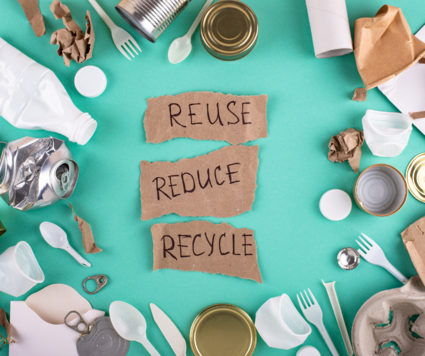WATER QUALITY IMPROVEMENTS

Zero-Waste New Year’s Resolutions to Prevent Stormwater Pollution
Happy New Year! Welcoming in a new year also means welcoming in New Year’s resolutions to protect our environment and preserve the quality of our waterways. One great way to do this is by reducing household waste and adopting a zero-waste lifestyle, which helps divert materials from landfills and prevent waste from polluting our waterways. Common household waste such as food, packaging, chemicals, and pet waste can easily pollute our waterways if not disposed of properly. If waste ends up on the ground rather than in the right bin, water runoff can carry it into the storm drain system where it enters our local waterways without being treated. Make your 2024 new year’s resolution to prevent waste from polluting our waterways by adopting these zero-waste habits inside and outside of your home!
|
Reducing Waste to Prevent Stormwater Pollution
A great way to kick off the new year is by doing a waste audit to see what items can be removed from your home or repurposed into something more usable. By preventing waste in the first place, you are reducing the potential of waste from leaving your home and eventually polluting our waterways. Why not coordinate your waste-saving efforts with National Organize Your Home Day on January 14th, a perfect opportunity to reduce clutter in your home while also preventing stormwater pollution and preserving the beauty of our waterways.
Follow these tips and review the resources below to protect our waterways while you minimize waste and clutter in your household:
-
Kitchen Waste like food scraps and food packaging can make their way into our streets and waterways if not disposed of properly. Learn how to set up a zero-waste kitchen and compost organic waste through the County’s Organic Waste program. Even though food scraps are natural, they still need to be managed properly to prevent bacteria and waste from polluting our waterways.
-
Household Hazardous Waste (HHW) such as fertilizers, pesticides, detergents, and paint can be toxic to aquatic life and human health if they reach our waterways. Properly dispose of any unused chemicals by taking them to a local HHW facility.
-
Larger items like couches, refrigerators, and mattresses can be donated or recycled and turned into new products, which keeps them out of alleys and streets and reduces the risk of blocked storm drain paths and flooding. Visit WasteFreeSD.org to find drop-off locations for recycling, donating, or disposing of large items.
-
Pet Waste contains harmful bacteria that can pollute our waterways and impact human and aquatic life if it’s not picked up. Learn how to adopt a Zero-Waste Pets lifestyle by taking actions to both properly dispose of pet waste and also minimize waste from products that you buy for your pet.
Zero-Waste Habits Outside Your Home – Keep the zero-waste mindset going by implementing waste-reduction habits into your lifestyle outside of your home. Whether you’re dining out, enjoying recreational activities like camping and boating, or at school or work, there’s an opportunity to reduce waste to keep trash and pollutants out of our storm drains to preserve the beauty and quality of our waterways.
The County wishes all its residents a very happy and zero-waste new year and encourages you to participate in the many stormwater pollution-prevention events offered by the County throughout the year.

|
|

|
|
Find My District
|

|
ONLINE SERVICES
Report Stormwater Pollution
Report observed pollution to the correct jurisdiction.
Citizen Access Portal
Research property information and permits. Apply for some permits online.
GIS Maps
Find property information including zoning designation with our web-based mapping tool.
Watershed Protection Website
sandiegocounty.gov/stormwater
Learn more about available water quality rebates that you could apply to your property!

Project Clean Water efforts are focused on providing a centralized point of access to water quality information and resources for San Diego County Watersheds. Click HERE to visit Project Clean Water’s website.
|

|
|